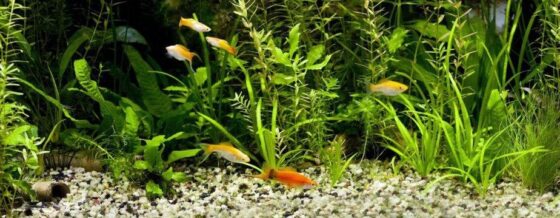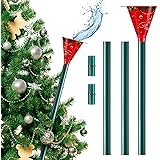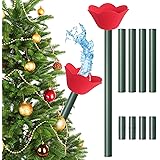Can dying aquarium plants kill fish? The answer is yes, and it’s a concern that many aquarium enthusiasts face. We all want our underwater gardens to thrive and provide a healthy environment for our fish. But sometimes, despite our best efforts, plants wither away and start to decay. It may seem like a minor issue, but the impact can be more significant than you might expect.
In this article, we will explore the potential dangers of dying aquarium plants and provide solutions to help you maintain a thriving aquatic ecosystem for your fish. So, if you’re worried about the well-being of your finned friends, keep reading to learn more about the hidden dangers that can lurk in your tank.
Can Dying Aquarium Plants Kill Fish?
Aquarium plants play a crucial role in maintaining a healthy and balanced aquatic ecosystem. They provide oxygen, absorb excess nutrients, and offer hiding places for fish.
However, when aquarium plants begin to deteriorate and die, they can have adverse effects on the fish living in the tank. In this article, we will explore the potential dangers of dying aquarium plants and how to prevent harm to your fish.
Effects of Dying Aquarium Plants on Water Quality
When aquarium plants die, they go through a process of decomposition. As the plants break down, they release various compounds into the water, which can significantly impact water quality. Here are some of the effects this can have on your fish:
- Ammonia Buildup:
One of the primary concerns of dying plant matter is the release of ammonia. Ammonia is toxic to fish and can rapidly accumulate in the water when plants decay. Increased ammonia levels can stress fish, damage their gills, and even lead to organ failure.
- Altered pH Level:
The decomposition process can also affect the pH level of the water. As plants decay, they release organic acids that can lower the pH, making the environment more acidic. Sudden changes in pH can be stressful for fish and disrupt their physiological processes.
- Nutrient Imbalance:
Dying plants can release excess nutrients into the water, such as nitrogen and phosphorus. While plants typically absorb these nutrients, an imbalance caused by decaying plants can promote the growth of harmful algae, leading to oxygen depletion, poor water clarity, and fish stress.
- Reduced Oxygen Levels:
When plants die, they no longer produce oxygen through photosynthesis. This can lead to a decrease in dissolved oxygen levels in the water, putting fish at risk of suffocation. Oxygen-deprived fish may exhibit gasping behavior at the water’s surface or become lethargic and weak.
Read More: About Can Chia Seeds Thrive In An Aquarium? Find Out!
Identifying Dying Aquarium Plants
Recognizing the signs of dying aquarium plants is crucial for promptly addressing the issue and safeguarding your fish. Here are some indicators that a plant may be deteriorating:
- Yellowing or Browning Leaves:
An unhealthy plant often exhibits yellow or brown leaves, which may be a sign of nutrient deficiency or poor water conditions.
- Wilting or Drooping:
Plants that appear wilted or drooping may be suffering from nutrient deficiencies, inadequate lighting, or root system problems.
- Decaying Roots:
If the roots of your plant are mushy, discolored, or falling apart, it indicates root rot. Root rot can be caused by overwatering, poor substrate, or nutrient imbalances.
- Stunted Growth:
If your plant is not growing or has stunted growth despite adequate care, it could be a sign of underlying issues that need attention.
- Excessive Algae Growth:
A dying plant can contribute to an imbalance in the aquarium, resulting in excessive algae growth on the plant itself or other surfaces.
Preventing Dying Aquarium Plants from Harming Fish
To prevent dying aquarium plants from harming your fish, it’s essential to address the underlying causes and take appropriate measures. Here are some preventive steps you can take:
- Maintain Proper Lighting:
Adequate lighting is crucial for the health of aquarium plants. Ensure that your plants receive the appropriate intensity and duration of light suitable for their species.
- Provide Sufficient Nutrients:
Regularly fertilize your plants to ensure they receive the necessary nutrients for growth. Use a balanced aquarium plant fertilizer and follow the recommended dosage based on your tank size.
- Control Algae Growth:
Algae can compete with aquarium plants for nutrients and light. Implement strategies to limit algae growth, such as maintaining proper water quality, reducing excess nutrients, and utilizing algae-eating fish or invertebrates.
- Prune and Remove Dead Plant Matter:
Regularly inspect your aquarium plants and prune any dead or decaying parts. Removing dying plant matter promptly can prevent it from negatively impacting water quality.
- Monitor Water Parameters:
Regularly test the water parameters in your aquarium to ensure they are within the appropriate range for both fish and plants. Pay attention to ammonia levels, pH, and nutrient levels to identify and address any imbalances.
- Proper Water Circulation and Oxygenation:
Maintaining good water circulation and aeration helps distribute nutrients to the plants and ensures adequate oxygenation for the fish. Consider using a suitable filter and adding an air pump if necessary.
Read More: About A Guide To Fertilizing Your Peace Lily
Additional Tips for a Healthy Aquarium
Incorporating the following practices into your aquarium maintenance routine can also contribute to a healthier and more vibrant aquatic environment:
- Choose Suitable Plant Species:
Select aquarium plants that are compatible with your tank setup and the specific needs of your fish. Research the requirements of different plant species before adding them to your aquarium.
- Establish a Balanced Ecosystem:
Introduce a variety of fish, invertebrates, and live plants that contribute to a balanced ecosystem. A diverse aquarium setup can help maintain stable water conditions and reduce the risk of issues caused by dying plants.
- Regular Water Changes:
Perform regular partial water changes to remove accumulated toxins, excess nutrients, and ensure overall water quality. This practice is vital for the health of both fish and plants.
- Quarantine New Additions:
Before introducing new fish or plants into your aquarium, consider quarantining them for a period to monitor their health and prevent the introduction of diseases or pests.
- Observe and Learn:
Regularly observe your aquarium to detect any signs of distress in fish or plants. Being attentive to changes in behavior or appearance can help you address issues promptly before they escalate.
While dying aquarium plants have the potential to harm fish, proactive care and preventive measures can minimize the risks. Regular monitoring, maintaining proper water parameters, providing adequate lighting and nutrients, and promptly addressing decaying plant matter are essential for creating a thriving aquatic ecosystem.
By following these guidelines, you can enjoy the beauty of healthy plants while ensuring the well-being of your fish. Remember, a well-maintained aquarium is a beautiful and harmonious home for all its inhabitants.
Frequently Asked Questions (FAQs)
Yes, dying aquarium plants can potentially harm or even kill fish in your aquarium. When aquarium plants start to deteriorate or die, they can have several negative impacts on the aquatic environment that can threaten the health and well-being of the fish in the tank. These effects primarily revolve around the deterioration of water quality and the release of harmful substances:
Ammonia and Nitrite Release: Dying plants release organic matter as they decay. This organic matter decomposes, leading to the release of ammonia and nitrites into the water. Both ammonia and nitrites are highly toxic to fish and can cause significant stress, illness, or even death.
Oxygen Depletion: As dying plants break down, they consume oxygen during the decomposition process. This can lead to a reduction in oxygen levels in the aquarium water. Lower oxygen levels can stress fish and, in severe cases, lead to suffocation.
pH and Water Hardness Changes: The decay of plant material can also alter the pH and water hardness in the aquarium. This can affect fish that have specific pH and hardness requirements, potentially causing stress and health issues.
To prevent these issues, it’s crucial to maintain healthy aquatic plants, promptly remove any dead or decaying plant material, conduct regular water changes, and monitor water parameters to ensure they remain within safe ranges for your fish. Proper care of both the plants and the fish will help maintain a balanced and healthy aquarium environment.
Several factors can cause aquarium plants to die. Proper care is essential to ensure the health and longevity of your aquatic plants. Here are some common reasons why aquarium plants may die:
Inadequate Lighting: Plants require proper lighting for photosynthesis. Inadequate or inconsistent lighting can lead to poor plant growth or cause them to die.
Incorrect Water Parameters: Water temperature, pH, and hardness should match the requirements of the specific plant species. Variations outside these parameters can stress and harm the plants.
Nutrient Deficiencies: Plants need essential nutrients such as nitrogen, phosphorus, potassium, iron, and trace elements to grow. A lack of these nutrients can result in stunted growth or plant death.
Poor Substrate: A suitable substrate is necessary for root development and nutrient uptake. Some plants require specific substrates, like nutrient-rich or inert substrates, depending on their needs.
Algae Competition: If algae thrive in the aquarium, they can outcompete plants for nutrients and light. This can lead to poor plant growth and death.
Invasive or Aggressive Species: Some plant species can outcompete and harm others. Invasive or aggressive plants may overshadow or inhibit the growth of more delicate species.
Improper Placement: Placing plants in the wrong location within the aquarium can impact their access to light and nutrients. Some plants may require different water flow rates or proximity to the substrate.
Overcrowding: Too many plants in a confined space can lead to overcrowding, hindering their growth and access to light.
Lack of Maintenance: Regular maintenance, including pruning, removing dead plant matter, and cleaning the substrate, is essential to maintain a healthy plant environment.
Disease and Pests: Plants can be susceptible to diseases and pests, such as snails, which can damage or consume plant material. Treating and preventing these issues is crucial.
Improper Plant Selection: Some plant species are more suitable for beginners due to their hardiness, while others are more challenging to grow. Choosing plants that match your skill level and aquarium conditions is important.
Carbon Dioxide (CO2) Imbalance: Some advanced planted aquariums use CO2 injection to promote plant growth. An imbalance in CO2 levels can affect plant health.
Water Quality: Poor water quality, with high levels of ammonia, nitrites, or nitrates, can stress plants and hinder their growth.
To maintain healthy aquarium plants, it’s crucial to research the specific needs of the plant species you intend to keep, provide suitable lighting, maintain proper water parameters, and regularly inspect and care for your plants as part of your overall aquarium maintenance routine.
When aquarium plants die, they begin to decay, releasing toxins into the water. These toxins can affect the water quality, leading to increased ammonia, nitrite, and nitrate levels, which are harmful to fish.
Poor water quality can stress fish, weaken their immune systems, and make them more susceptible to diseases. It can also lead to oxygen depletion and create an inhospitable environment for fish to thrive.
Yes, fish can get poisoned by decaying plant matter as it releases harmful substances like hydrogen sulfide and organic acids. These substances can cause health problems or even lead to fish death.
To prevent dying aquarium plants from harming your fish, it is important to maintain good water quality by regularly testing the parameters and addressing any issues promptly. Additionally, proper plant care, including proper lighting, nutrient supplementation, and pruning, can help prevent plant decline.
Yes, it is recommended to remove dying plants from the aquarium as soon as possible. Removing them prevents further decay and reduces the release of toxins into the water.
Yes, some signs that dying plants are negatively affecting fish include increased stress levels, decreased appetite, abnormal swimming behavior, fin rot, or other visible health issues. Regularly observing your fish can help you identify these signs.
Yes, live plants can improve water quality in aquariums by absorbing nutrients, converting carbon dioxide into oxygen, and providing additional hiding places for fish. They can also help to mimic a more natural habitat for fish, promoting their overall health and well-being.
Final Thoughts
Dying aquarium plants can indeed pose a threat to the fish living in the tank. As plants die, they release organic matter into the water, which can lead to an increase in ammonia levels. High ammonia levels can be toxic to fish, causing stress, illness, and even death.
Additionally, decaying plants can create a breeding ground for harmful bacteria and fungi, further endangering the fish. To maintain a healthy and safe aquarium environment, it is crucial to regularly monitor and remove any dying or decaying plants. Can dying aquarium plants kill fish? Yes, they can. Taking proactive measures to keep the plants healthy is essential for the well-being of the fish.
Auto Amazon Links: No products found.
Perfect Plants Christmas Tree Saver 8oz. | Easy Use Xmas Tree Preserver Food | Have Healthy Green Christmas Trees All Holiday Season
$9.97 (as of December 13, 2025 05:07 GMT +00:00 - More info- Product prices and availability are accurate as of the date/time indicated and are subject to change. Any price and availability information displayed on [relevant Amazon Site(s), as applicable] at the time of purchase will apply to the purchase of this product.
Rocky Mountain Goods Christmas Tree Food - 8 oz Tree Preservative - Reduce Needle Drop - Greener Scent - Fir, Pine, Spruce Trees - Extend Tree Life
$9.95 (as of December 13, 2025 05:07 GMT +00:00 - More info- Product prices and availability are accurate as of the date/time indicated and are subject to change. Any price and availability information displayed on [relevant Amazon Site(s), as applicable] at the time of purchase will apply to the purchase of this product.
FirEver Pure Christmas Tree Food | Preserver Additive & Season Extender for Live Xmas Trees | Keep It Green, Reduce Needle-Drop | Miracle Freshness (8 oz)
$14.99 (as of December 13, 2025 05:07 GMT +00:00 - More info- Product prices and availability are accurate as of the date/time indicated and are subject to change. Any price and availability information displayed on [relevant Amazon Site(s), as applicable] at the time of purchase will apply to the purchase of this product.
VICAMB 39.3 Inch Christmas Tree Watering Funnel,Christmas Tree Watering System Device,Long Tree Watering Funnel Spout for Indoor Outdoor Xmas Tree
$16.99 (as of December 13, 2025 05:07 GMT +00:00 - More info- Product prices and availability are accurate as of the date/time indicated and are subject to change. Any price and availability information displayed on [relevant Amazon Site(s), as applicable] at the time of purchase will apply to the purchase of this product.
EZMeetU Christmas Tree Watering Funnel, 47 Inch Flower Shape Adjustable 6 Section Design, Christmas Tree Watering System, Christmas Tree Waterer, Long Funnel Wide Opening Reusable, Plant Watering Tool
$16.99 (as of December 13, 2025 05:07 GMT +00:00 - More info- Product prices and availability are accurate as of the date/time indicated and are subject to change. Any price and availability information displayed on [relevant Amazon Site(s), as applicable] at the time of purchase will apply to the purchase of this product.
Snow Joe Premium Enviro Blend Ice Melt, Green-Coated Deicer Crystals, 50 lb - Safer Melter for Vegetation, Concrete & Metals w/ Anti-Corrosion Calcium Magnesium Acetate
$32.97 (as of December 12, 2025 19:27 GMT +00:00 - More info- Product prices and availability are accurate as of the date/time indicated and are subject to change. Any price and availability information displayed on [relevant Amazon Site(s), as applicable] at the time of purchase will apply to the purchase of this product.
Muddy Mat® Shown on TV Super Absorbent Microfiber Dog Door Mat for Muddy Paws, Non-Slip Washable Pet Rug, Quick Dry Chenille Entryway Carpet, Machine Washable Indoor Outdoor mat, Grey 30"x19"
$24.95 (as of December 12, 2025 19:27 GMT +00:00 - More info- Product prices and availability are accurate as of the date/time indicated and are subject to change. Any price and availability information displayed on [relevant Amazon Site(s), as applicable] at the time of purchase will apply to the purchase of this product.
ivtivfu Rolling Grill Basket, Removable Wooden Handle, 304 Stainless Steel, Nesting BBQ Tools, Smoker Grilling Accessories for Vegetable, Outdoor Cooking Camping, Birthday Gifts for Men Dad Husband
$25.99 (as of December 12, 2025 19:27 GMT +00:00 - More info- Product prices and availability are accurate as of the date/time indicated and are subject to change. Any price and availability information displayed on [relevant Amazon Site(s), as applicable] at the time of purchase will apply to the purchase of this product.
XXXFLOWER Plant Terrarium with Wooden Stand, Air Planter Bulb Glass Vase Metal Swivel Holder Retro Tabletop for Hydroponics Home Garden Office Decoration - 3 Bulb Vase
$18.98 (as of December 12, 2025 19:27 GMT +00:00 - More info- Product prices and availability are accurate as of the date/time indicated and are subject to change. Any price and availability information displayed on [relevant Amazon Site(s), as applicable] at the time of purchase will apply to the purchase of this product.
Zevo Flying Insect Trap Official Refill Cartridges - Fits Both Zevo Trap & MAX Indoor Fly Trap - Authentic Trap+Lock Technology to Catch Gnats, House & Fruit Flys (4 Official Refill Cartridges)
$14.97 (as of December 12, 2025 19:27 GMT +00:00 - More info- Product prices and availability are accurate as of the date/time indicated and are subject to change. Any price and availability information displayed on [relevant Amazon Site(s), as applicable] at the time of purchase will apply to the purchase of this product.











